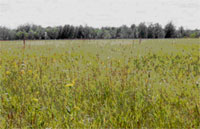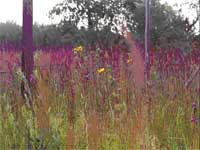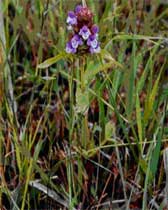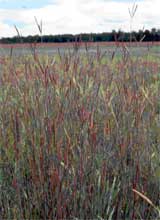Role Of Seedbanks In The Restoration Of Tallgrass Prairie (Manitoba) (2003)
By Julie Sveinson and Stéphane McLachlan
Julie Sveinson received her Masters of Science from the University of Manitoba in Botany in 2003. The focus of her research was habitat restoration, specifically restoring tall grass prairie. Since 2002, she has been working with the City of Winnipeg’s Naturalist Services Branch in natural area management and environmental education. As the Revegetation Education Coordinator, Julie has worked with a number of volunteer Stewardship groups to restore and enhance Winnipeg’s natural areas.
Dr. Stéphane McLachlan is an Associate Professor in the Department of Environment and Geography at the University of Manitoba. He is always looking to partner with highly motivated and community-minded undergraduate and graduate students as well as post-docs interested in environmental conservation, ecological restoration, and the interface between human and biophysical systems.
Most restored tallgrass prairies in Manitoba are constructed habitats. Although restoration of existing but degraded natural habitat has great potential for success (McDonald 2000), little information about restoring degraded tallgrass prairie exists for our region. Since 1999, we have investigated the effects of various treatments — including fertilization, disturbance, and seeding — on a 4-acre (1.6-ha), post-agricultural site (Sveinson 2003) within the Manitoba Tall Grass Prairie Preserve in southeastern Manitoba. In this note, we highlight one part of this study in which we examined the potential use of glyphosate herbicide as a tool for releasing the native seedbank of degraded sites.
Prior to treatment, our study site was dominated by non-native grass species, including redtop (Agrostis stolonifera), timothy (Phleum pratensis), Canada bluegrass (Poa compressa), and smooth brome (Bromus inermis). Native species were less common and included big bluestem (Andropogon gerardii), granular sedge (Carex granularis) and stiff goldenrod (Solidago rigida). We established four 48-m × 32-m herbicide treatment plots in this four-times replicated experiment and an equivalent number of untreated control plots. Originally, we were interested in comparing a conventional restoration technique (tillage and herbicide application) with interseeding. However, a previously undocumented population of the endangered Great Plains ladies’-tresses (Spiranthes magnicamporum) emerged three days after we applied herbicide, precluding any subsequent mechanical or chemical treatments.
We sampled the vegetation cover of all plant species within four permanent 1-m × 1-m quadrats in each treatment plot. We also sampled four plots at a neighboring reference site that we used to identify any treatment-related changes in vegetation. To assess the seedbank species composition, we collected four soil samples within each of the treatment and reference plots. We mixed soil samples with equal proportions of a sterile mix (Sunshine Mix 4 Aggregate Plus) and placed them in 4-inch × 6-inch × 3-inch (10-cm × 15-cm × 8-cm) pots within the greenhouse. We identified and removed seedlings as they emerged. When the seedbank was exhausted, we cold-stratified the samples at 36°F (2°C) for six weeks and repeated the procedure once. We found that the seedbank of the degraded prairie had significantly higher diversity and density of both native and exotic graminoids (grasses, sedges, and rushes), and it tended to have higher diversity of exotic forbs. In contrast, the reference site had significantly higher native forb diversity and density.
In spring 2000, we observed that 80-95 percent of aboveground vegetation in the treatment plots died following the glyphosate application the previous August. Plant re-growth was extremely slow and vegetation did not green-up until late August 2000. We used t-tests to determine whether glyphosate had a significant effect on aboveground species richness (total number of species) and effective species richness (reciprocal of Simpson’s diversity measure). We measured the latter because it is relatively insensitive to rare species. Two years after glyphosate application, we found that effective species richness for both exotic and native species had decreased significantly. Native species richness also decreased significantly, whereas no difference was found in exotic species richness (Sveinson 2003). Both glyphosate-treated and untreated plots were dominated by exotics redtop, Canada bluegrass, and common self-heal (Prunella vulgaris). In contrast, reference plots were dominated by native graminoids such as big bluestem and prairie cordgrass (Spartina pectinata) (Table 1).
Herbicide-associated mortality of vegetation in the treatment plots likely resulted in recolonization of exotic species that dominated the seed and propagule banks, and further created opportunities for establishment by wind- and/or vector-dispersed species (Sveinson 2003). All exotic graminoids that increased in dominance in the herbicide-treated plots — redtop and Canada bluegrass — were found in the seedbank. Other exotic forb species, such as Canada thistle (Cirsium arvensis) and common self-heal, were not found in the seedbank, but were present in neighbouring seedbanks and may have colonized from surrounding areas. These results suggest that seedbanks can greatly affect the outcome of a restoration project. We strongly recommend characterizing both aboveground and seedbank species in order to increase the likelihood of success.
Acknowledgments
Support for this study was provided by the National Sciences Engineering and Research Council of Canada, University of Manitoba, Canadian Wildlife Foundation, Critical Wildlife Habitat Program, and Prairie Habitats Inc., Manitoba. We thank the Environmental Conservation Lab at the University of Manitoba, summer field technicians, and the Manitoba Tall Grass Prairie Preserve for assistance in the field.
- McDonald, T. 2000. Resilience, recovery and the practice of restoration. Ecological Restoration. 18:10-20.
- Sveinson, J. 2003. Restoring tallgrass prairie in southern Manitoba, Canada. M.S. thesis. University of Manitoba. Winnipeg, Manitoba, Canada.
- SER/ESA 2002
Table 1. Five most dominant species found in the treatment and reference plots. Species were ranked based on average percent cover estimates in 1m × 1m quadrats. [citation]
| Latin Name | Common Name | Glyphosate1 | No Glyphosate | Reference site |
|---|---|---|---|---|
| Native Species | ||||
| Andropongon gerardii | Big bluestem | - | 6 | 1 |
| Antennaria neglecta | Field pussytoes | 28 | 5 | 32 |
| Carex granularis | Granular sedge | 2 | 2 | 13 |
| Carex spp. | Sedge species | 8 | 4 | 4 |
| Eleocharis palustris | Common spike rush | 5 | - | 6 |
| Juncus spp. | Rush Species | 15 | 18 | 43 |
| Spartina pectinata | Prairie cordgrass | - | - | 2 |
| Exotic Species | ||||
| Agrostis stolonifera | Redtop | 1 | 3 | 3 |
| Festuca elatior | Tall meadow fescue | 4 | 10 | - |
| Poa compressa | Canada bluegrass | 7 | 1 | 20 |
| Prunella vulgaris | Common self-heal | 3 | 8 | 5 |

Plate 1 Degraded tallgrass prairie within the Manitoba Tall Grass Prairie Preserve.

Plate 2 Neighbouring reference site within the Manitoba Tall Grass Prairie Preserve.

Plate 3 Non-native forb common self-heal (Prunella vulgaris).

Plate 4 Native graminoid big bluestem (Andropogon gerardii).
Sveinson, J. and McLachlan, S. "Role of Seedbanks in the Restoration of Tallgrass Prairie (Manitoba)". Ecological Restoration. 21(1)(2003). 43-44.